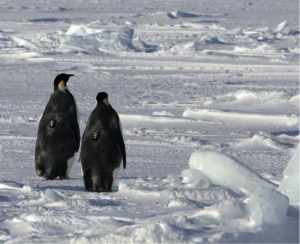Emperor penguin post-molt foraging behavior (In collaboration with Dr. Gerald Kooyman)
 Emperor penguins dive deeper and longer, fast longer, and endure the harshest weather conditions of all diving birds. They spend about four to five months after the breeding season deep in Antarctic pack ice, far from shore and any stations. During this time they undergo great changes in body weight as they feed to
Emperor penguins dive deeper and longer, fast longer, and endure the harshest weather conditions of all diving birds. They spend about four to five months after the breeding season deep in Antarctic pack ice, far from shore and any stations. During this time they undergo great changes in body weight as they feed to
recover from the breeding season, lose weight while fasting during the molt, and then continue to feed before the breeding season. Unfortunately, due to their remote location little is known about the foraging ecology and diving behavior during this critical period. In March of 2013 we travelled deep into the Antarctic pack ice in the Eastern Ross Sea to instrument emperor penguins after they molted. The objectives of the study were: 1) Place satellite/time depth recorder tags on 20 adult post molt birds to determine their route, rate of travel, and diving behavior as they return back to their breeding colonies, 2) Obtain an index of body condition, 3) Collect guano to determine the type of food consumed by emperor penguins in the region, 4) Conduct shipboard surveys to sight and plot the location and abundance of adult and juvenile birds on the ship’s track. We are currently finishing up analysis. You can check out the blogs and video from the cruise here: Scripps Article, Tracers Blog, National Geographic Blog, Time-lapse video
Drs. Birgitte McDonald and Jerry Kooyman are excited about the findings and have submitted a proposal to continue this research.

